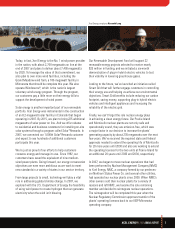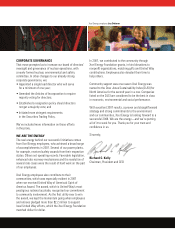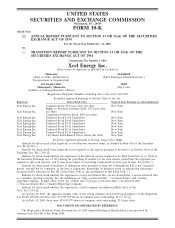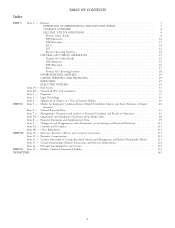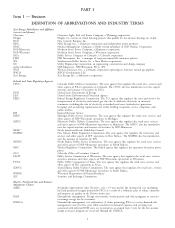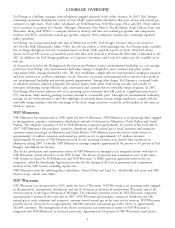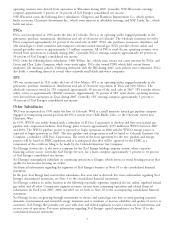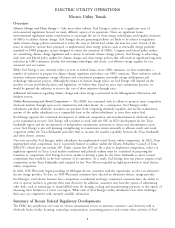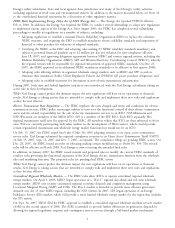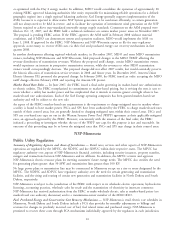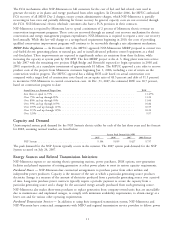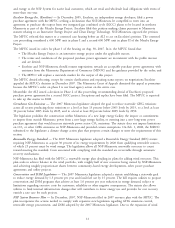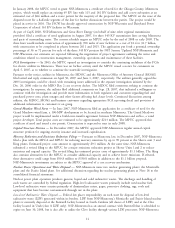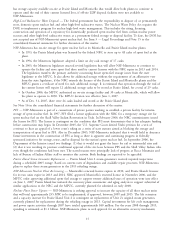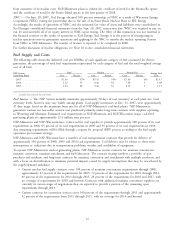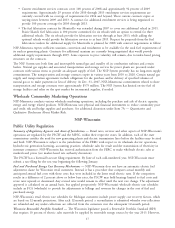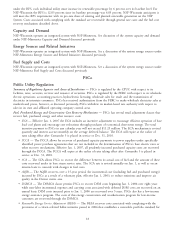Xcel Energy 2007 Annual Report Download - page 19
Download and view the complete annual report
Please find page 19 of the 2007 Xcel Energy annual report below. You can navigate through the pages in the report by either clicking on the pages listed below, or by using the keyword search tool below to find specific information within the annual report.Energy’s utility subsidiaries. State and local agencies have jurisdiction over many of Xcel Energy’s utility activities,
including regulation of retail rates and environmental matters. In addition to the matters discussed below, see Note 14
to the consolidated financial statements for a discussion of other regulatory matters.
FERC Rules Implementing Energy Policy Act of 2005 (Energy Act) — The Energy Act repealed PUHCA effective
Feb. 8, 2006. In addition, the Energy Act required the FERC to conduct several rulemakings to adopt new regulations
to implement various aspects of the Energy Act. Since August 2005, the FERC has completed several rulemaking
proceedings to modify its regulations on a number of subjects, including:
• Adopting regulations to establish a national Electric Reliability Organization (ERO) to replace the voluntary
NERC structure, and requiring the ERO to establish mandatory electric reliability standards and imposition of
financial or other penalties for violations of adopted standards;
• Certifying the NERC as the ERO and adopting rules making 83 NERC reliability standards mandatory and
subject to potential financial penalties up to $1 million per day per violation for non-compliance effective
June 18, 2007; and approving delegation agreements between NERC and various regional entities, including the
Midwest Reliability Organization (MRO), SPP and Western Electricity Coordinating Council (WECC), whereby
the regional entities will be responsible for regional enforcement of approved NERC standards. On Dec. 21,
2007, the FERC approved seven additional NERC mandatory standards to be effective in first quarter 2008;
• Adopting rules allowing utilities in organized wholesale energy markets such as MISO and SPP to seek to
eliminate their mandatory Public Utility Regulatory Policies Act (PURPA) QF power purchase obligations; and
• Adopting rules to establish incentives for investment in new electric transmission infrastructure.
During 2007, both state and federal legislative initiatives were introduced, with the Xcel Energy subsidiaries taking an
active role in their development.
While Xcel Energy cannot predict the ultimate impact the new regulations will have on its operations or financial
results, Xcel Energy is taking actions that are intended to comply with and implement these new rules and regulations
as they become effective.
Electric Transmission Rate Regulation — The FERC regulates the rates charged and terms and conditions for electric
transmission services. FERC policy encourages utilities to turn over the functional control of their electric transmission
assets and the related responsibility for the sale of electric transmission services to an RTO. NSP-Minnesota and
NSP-Wisconsin are members of the MISO RTO. SPS is a member of the SPP RTO. Each RTO separately files
regional transmission tariff rates for approval by the FERC. All members within that RTO are then subjected to those
rates. PSCo is currently participating with other utilities in the development of WestConnect, which would provide
certain regionalized transmission and wholesale energy market functions but would not be an RTO.
On Feb. 15, 2007, the FERC issued final rules (Order No. 890) adopting revisions to its open access transmission
service rules. Xcel Energy submitted the required compliance revisions to its Open Access Transmission Tariff (OATT)
on July 13, 2007, Sept. 11, 2007 and Dec. 7, 2007, as required. The compliance filings are pending FERC action. On
Dec. 28, 2007, the FERC issued an order on rehearing making certain modifications to Order No. 890. The revised
rules will be effective in March 2008. Xcel Energy is now reviewing the amended final rules.
In addition, in January 2007, the FERC issued interim and proposed rules to modify the current FERC standards of
conduct rules governing the functional separation of the Xcel Energy electric transmission function from the wholesale
sales and marketing function. The proposed rules are pending final FERC action.
While Xcel Energy cannot predict the ultimate impact the new regulations will have on its operations or financial
results, Xcel Energy is taking actions that are intended to comply with and implement these new rules and regulations
as they become effective.
Centralized Regional Wholesale Markets — The FERC rules allow RTOs to operate centralized regional wholesale
energy markets. On April 1, 2005, MISO began operation of a ‘‘Day 2’’ regional day-ahead and real time wholesale
energy market. MISO uses security constrained regional economic dispatch and congestion management using
Locational Marginal Pricing (LMP) and FTRs. The Day 2 market is intended to provide more efficient generation
dispatch over the 15 state MISO region, including the NSP System. In 2007, SPP began operation of an Energy
Imbalance Service (EIS) market, which will provide a more limited wholesale energy market for the region that includes
the SPS system.
On Sept. 14, 2007, MISO filed for FERC approval to establish a centralized regional wholesale ancillary services market
(ASM) in the second quarter of 2008. The ASM is intended to provide further efficiencies in generation dispatch by
allowing for regional regulation response and contingency reserve services through a bid-based market mechanism
9


